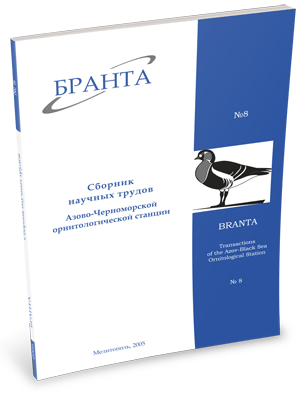
Transactions
of the Azov-Black Sea Ornithological Station



Species composition, seasonal dynamics and habitat distribution of Ciconiiformes in the South Crimea
Beskaravayny M.M.
In the south of the Crimea Ciconiiformes still remain poor studied. This paper is related to their species composition, typical features of their seasonal stay and role of main habitats.
Material and methods
Results of twenty-nine years study (1976-2004) of Ciconiiformes at the southern Crimean coast are analyzed. Regular investigations were taken on 4 plots. All facts of seeing Ciconiiformes were recorded as well as numbers of birds, habitat types and direction of flights. Own data included over 800 local observations and counts of bird numbers.
Brief characteristics of the investigated area
The southern coast of the Crimea covers the submediterranean area of the mountainous Crimea. The coastline stretches for 160 km. The climate is submediterranean, winter is warm. Vegetation belongs to lower forest-steppe zone. Landscape and ecological characteristics are favourable for using the region by birds as both a migratory corridor and wintering grounds.
Species compostion
The data are given on characteristics and period of stay for 13 species: Botaurus stellaris (L.,), Ixobrychus minutus (L.), Nycticorax nycticorax (L.), Ardeola ralloides (Scop.), Bubulcus ibis (L.), Egretta alba (L.), Egretta garzetta (L.), Ardea cinerea L., Ardea purpurea L., Platalea leucorodia L., Plegadis falcinellus (L.), Ciconia ciconia (L.), Ciconia nigra (L.).
General trends of seasonal dynamics
Maximal diversity of birds is observed during the spring passage (13 species) that lasts from February-March to May. Direction of the passage mainly follows the coastline, for some species eastern and northeastern directions predominate. In mid-summer 9 species are usually met, Grey Heron regularly. Autumn migration (at least 11 species) lasts from August to October, regularity of observations and numbers of birds are lower than in spring. Four species winter, Great White Egret regularly.
Habitats
The following landscape-habitat elements are used: 1) Water bodies of natural (LakeBarakol') and anthropogenic origin, watercourses (11 species, Little Bittern breeds). Development of artificial water bodies resulted in distribution of Little Bittern and improvement of feeding conditions for passage and wintering birds (7 species are regularly observed); 2) seashore (9 species, Squacco Heron and Little Egret prefer this habitat); 3) lignosa vegetation (9 species, Night Heron was registered the most frequently).
Conclusion
Thirteen species of Ciconiiformes are registered. Little Bittern breeds, other species passage, roam or stay for winter. Birds use such habitats as freshwater bodies, seashore and sparse lignosa vegetation. Watering of Crimean steppes caused changes in numbers and passage periods of 4 species.
Read the paper in a PDF file